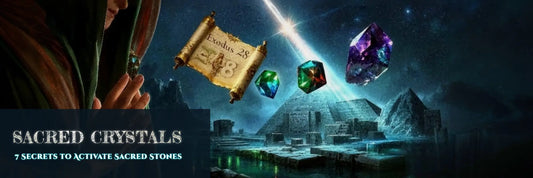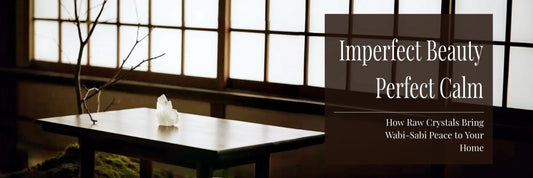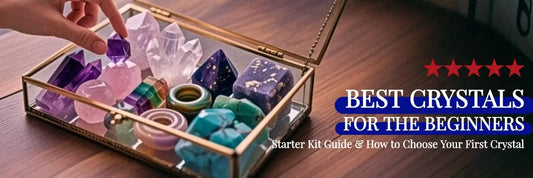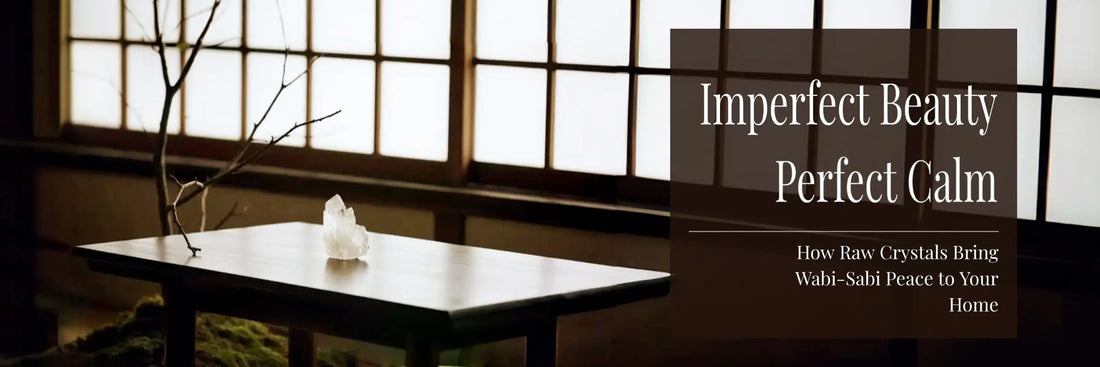
Imperfect Beauty, Perfect Calm: How Raw Crystals Bring Wabi-Sabi Peace to Your Home
VioletFernPartager
Introduction
These days, life moves fast with lots of noise, constant phone alerts, and too much stuff everywhere. It's important to find peace at home.
Japanese idea called Wabi-sabi teaches us to slow down, take deep breaths, and enjoy the simple, real beauty around us — even if things aren't perfect.
When you add healing crystals to this way of thinking, your home can feel like a calm, peaceful place where you can relax and feel connected.
I. Wabi-Sabi Aesthetics: The Eternal Philosophy in Imperfection
I-1. Core Definition and Cultural Heritage
Wabi-Sabi, an ancient Japanese philosophical concept, advocates discovering the essence of beauty in imperfection, transience, and incompleteness. It emphasizes embracing the authentic state of things and the laws of nature.
I-2. Origins and Evolution
Wabi-sabi is an old Japanese way of thinking that loves things that are imperfect, temporary, and unfinished. It started about 600 years ago with Buddhist monks and tea masters who liked simple, natural things instead of fancy stuff.
Emerging Period:
Laid the foundation by Zen Buddhist monks and tea masters, such as Sen no Rikyu.
They opposed ostentatious aesthetics and promoted the philosophy of "simplicity and naturalness" in life.
Core Components:
- Wabi: Seeking inner beauty in solitude and simplicity, like the tranquility of the mind during solitude and the rustic texture of rough pottery tea sets.
- Sabi: The serene beauty forged by time, such as the mottled patterns on ancient wood and the patina of old objects.
I-3. 3 Key Characteristics of Wabi-Sabi
- Admiration for Imperfection: Cracked pottery, faded fabrics, asymmetrical shapes — flaws tell stories, and incompleteness reveals vitality.
- The Poetics of Time: Appreciating "marks of time" like rust, weathering, and wear, viewing change as a dynamic continuation of beauty.
- Concept of Symbiosis with Nature: Rejecting excessive processing, embracing the knots of raw wood, the texture of stones, and the cycle of growth and decay in plants.
I-4. Design Practice: The Spatial Interpretation of Wabi-Sabi Aesthetics
| DESIGN DIMENSION | CORE FEATURES | EXAMPLE ELEMENTS |
|---|---|---|
| Material Selection | Natural and raw, preserving natural traces | Coarse pottery, linen, unpolished wood, handmade paper |
| Color System | Low-saturation, earthy tones, emphasizing "the beauty of fading" | Terracotta, khaki, misty white, dark brown |
| Spatial Layout | Emphasizing emptiness, rejecting clutter, preferring quality over quantity | Vast open spaces, a few antique furnishings |
| Philosophy of Objects | Rejecting "trendy items," choosing "things with stories" that show signs of use | Heirloom wooden spoons, repaired tea bowls, old fabrics |
I-5. Manifestations of Wabi-Sabi in Life and Its Modern Resonance
The Wabi-Sabi of Daily Life
- Beauty of Objects: Cracked tea bowls, handcrafted pottery.
- Spatial Imagery: The dancing shadows of wrinkled curtains in the light, the varying traces on an old wooden table.
- Spiritual Insights: Accepting life's imperfections —just as the natural cracks and inclusions in Crystals are the "unique fingerprints" of the Earth's billion-year evolution.
Contemporary Value Extensions
- Countering Consumerism: Rejecting the commercial notion that "perfection equals correctness," advocating for "the true beauty of imperfection."
- Mental Healing: Finding inner peace and a sense of belonging by accepting "impermanence" and "incompleteness."
- Ecological Philosophy: Echoing the concept of sustainability, and the wisdom of living in harmony with nature.
Conclusion
Wabi-Sabi aesthetics is not just an aesthetic paradigm but also a life attitude.
It allows us to perceive the tenderness of time in fading, encounter our true selves in imperfection, and understand the essence of eternity in transience.
Just like unpolished crystals, those so-called "flaws" are precisely the warmth that makes beauty truly tangible.
II. Why Use Crystals in Wabi-sabi Spaces?
II-1. Crystals: Wabi-Sabi's Natural Allies
- Imperfection as Identity: Rough edges, inclusions make each crystal unique, embodying wabi-sabi's authentic beauty.
- Geological Artistry: Formed by earth's pressure and heat, internal marks are nature's signature, not flaws.
- Serene Presence: In wabi-sabi spaces, crystals soothe with quiet energy, grounding the environment.
II-2. How Crystals Benefit You
- Feel steady inside when you're upset (like Smoky Quartz)
- Slow down and focus on the moment (Clear Quartz, called the "master healer")
- Stay calm when life feels too much (Amethyst or Rose Quartz)
- Enjoy small peaceful moments — like lighting incense, writing in a notebook, or just breathing
Crystals are more than things — they become a way to reconnect with yourself every time you see or touch them. That's what Wabi-sabi is about: not just looking, but feeling.
Sheehas crystals embody this too. With rough textures, true hues, and soft energy, our stones support real life, not perfection.
II-3. Must-Have Crystals for Wabi-sabi Spaces
- Smoky Quartz — helps you feel steady and simple
- Clear Quartz — helps clear your mind and keep things simple
- Rose Quartz — brings softness and emotional safety
- Green Aventurine — connects you to nature and calm
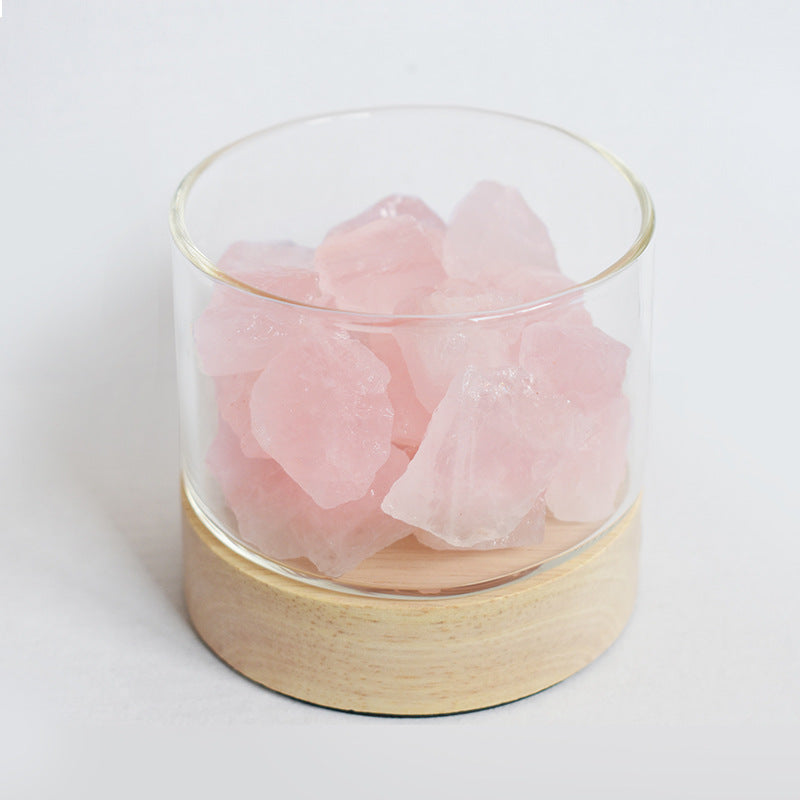
Rose Quartz Diffuser Stone
Let your space feel soft and quiet, a place to think and feel calm but alive.
III. How to Build a Wabi-sabi Crystal Corner
Making a Wabi-sabi crystal corner isn't about buying lots of stuff. It's about picking things carefully, placing them with meaning, and giving each item space to shine. Here's how to create your own calm, balanced, and natural crystal spot.
III-1. Pick Natural Crystals
Start with raw or lightly polished stones. Choose ones that look natural and soft — matte surfaces, little cracks, and natural shapes are perfect.
These crystals carry the quiet, honest energy of Wabi-sabi — real and imperfect.
Here are some to try:
- Smoky Quartz — Like morning fog, it helps clear stress and keeps you grounded
- Clear Quartz — Clear and simple, it helps boost your good intentions
- Rose Quartz — Soft pink and gentle, it's about love and kindness
- Green Aventurine — Calm and fresh like moss, it helps you connect with nature
Recommended for your collection
- Raw Rose Quartz Necklace
- Green Aventurine Healing Stone
- Smoky Quartz Energy Crystal
- Clear Quartz Crystal
Choose the crystal that speaks to your feelings — even if it's rough or uneven. That's part of its beauty.
III-2. Less Stuff = More Peace
Wabi-sabi loves empty space. One stone placed carefully can make a room feel much calmer than a lot of stuff piled up. Think of your space like a quiet pause — open, peaceful, and meaningful.
Try these ideas:
- Put a clear quartz on a wooden shelf to bring in light and clarity
- Place a rose quartz on your nightstand to invite loving dreams
- Set a smoky quartz by the front door to block stress and keep you grounded
Tip:
Leave space around each crystal. Empty space helps your mind relax and makes each stone feel special.
III-3. Mix Natural Materials
Wabi-sabi is about how things feel — not just how they look. Mix your crystals with natural materials that age well and feel soft and real.
Add:
- Soft linen or cotton — relaxed and a little wrinkled, not perfect
- Handmade pottery — like a chipped teacup that shows its story
- Natural items — driftwood, dried flowers, or stones from a river
You don't have to match colors or styles. Let things be different — that makes a calm, quiet harmony like in nature.
IV. Little Rituals Matter

Wabi-sabi isn't just about how a space looks — it's about how it makes you feel over time. The small things you do every day can change your mood, mind, and energy.
That's where crystals help — not by shining bright, but by quietly being there when things are calm.
Try these easy rituals:
- Light a candle at sunset and watch its light flicker on your crystal
- Hold your favorite stone while doing deep breathing or drinking tea
- Write down your thoughts next to your crystal to feel calm and clear

Tree of Life Natural Crystal Magic Notebook | Record Your Journal
Even little things, like moving a crystal to dust under it, become a special moment — a reminder to yourself: I deserve peace."
Rituals don't have to be big or spiritual — just done on purpose. In Wabi-sabi homes, even lighting incense or putting a crystal by your morning coffee is a way to be present.
V. Bring Wabi-sabi into Every Room
Wabi-sabi isn't just for one room — it's a way to fill your whole home with calm, meaning, and care.
You don't need to change everything. Just placing a few crystals in the right spots can change the feeling in each room:
Bedroom
Put a rose quartz on your nightstand or under your pillow. Its gentle energy helps ease feelings and supports deep, loving sleep. You might even have calmer dreams.
Living Room
Place a clear quartz cluster on your coffee table or shelf. It reflects light, brightens the room, and helps people feel open and focused.
Entryway
Set a smoky quartz near the door — on a shelf, bench, or shoe rack. It quietly soaks up stress and helps you feel grounded when you come and go.
Tip:
Don't worry too much about where to put them. The best spots usually feel peaceful and right.
VI. Final Thought: Real > Perfect
-
Wabi-sabi in a "perfect" world:
- Amidst the chase for flawlessness, Wabi-sabi affirms: You and your home—with chipped vases, old pillows, rough crystals—are enough, calm and honest.
-
Meaningful crystals:
- Beyond looks, they symbolize strength, clarity, love, presence. Their marks mirror real, imperfect healing.
-
Breathe, feel, let go:
- Let your home breathe with you—soft, steady, true.
Which crystal resonates with your wabi-sabi home?
Share your experience!
VII. FAQ — Frequently Asked Questions
:What is Wabi-sabi and how is it different from minimalism?
:Wabi-sabi is a Japanese way of living that accepts beauty in things that are imperfect, changing, and unfinished.
It focuses not just on having a simple space, but on natural, honest, and worn items that show the passage of time.
Minimalism, by comparison, mainly cares about having fewer things and keeping spaces very clean and tidy. Wabi-sabi celebrates the personality, history, and feelings in your items.
[Section 1]
:Why choose natural or raw crystals for Wabi-sabi spaces?
:Natural and raw crystals keep their unique patterns, cracks, and marks made by nature and time.
These "flaws" show the crystal's life story and make your space feel real and full of emotion. Wabi-sabi loves these imperfect details instead of shiny, polished crystals.
[Section 3-1]
:How do I place crystals in different rooms to improve the energy?
:Think about what each room is for and what you need.
For example,
- Put rose quartz in the bedroom to support healing and good sleep.
- Clear quartz in the living room helps bring focus and energy.
- Smoky quartz by the door can absorb bad energy and keep you grounded.
Make sure each crystal has some space around it to "breathe" and avoid clutter.
[Section 5]
:How can I use simple daily rituals with crystals to improve my mood and focus?
Crystals work best when you use them during calm, focused moments.
You might light a candle and watch its light on the crystal, hold your stone during meditation, or write in your journal with a crystal nearby.
These small, intentional actions help you feel calm and clear.
[Section 4]
:How do I pick the right "spiritual partner" crystal using Wabi-sabi?
:Besides looks, pay attention to how a crystal feels to you.
Wabi-sabi values your intuition and connection. Touch your crystals and choose the one that feels calm, comfortable, or tells a story.
That crystal becomes more than decoration — it supports your personal growth.
:How can Wabi-sabi help me slow down and relax in today's fast life using crystals?
:Wabi-sabi encourages slow living and being real.
Use crystals to make a quiet spot in your home where you spend a few minutes each day feeling the crystal's texture and energy.
Simple breathing or meditation with your crystal can help reduce stress and refresh your mind and body.
:How does Wabi-sabi's love for imperfection affect modern home design with crystals?
:Today's designers add Wabi-sabi by choosing crystals that keep their natural look — with cracks, color changes, and rough textures.
These crystals become the centerpieces that add warmth and realness to a room, not just shiny decorations.
:How do I avoid "over-beautifying" crystals and lose the Wabi-sabi spirit?
:Over-polishing or changing crystals too much can make them look fake and lose their natural charm.
To respect Wabi-sabi, pick stones with natural marks and textures. These rough edges show their life and healing power better than perfect, shiny ones.
[Section 2-1]




